Don’t Pass This Plate
Proposed Florida License Plate
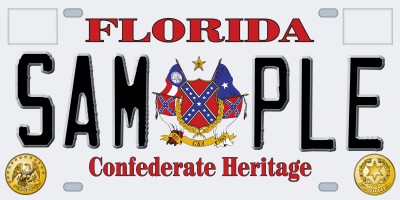
While Sinfonian has a visceral reaction to this proposed new Florida plate, I take personal umbrage at the historical frauds it perpetuates – the only things that are “authentic” and actually deal with the “heritage” of Florida are the buttons on the bottom of the graphic.
The “beneficiary” of the extra fee for this proposed license plate are the Sons of Confederate Veterans, which was once a standard organization for people interested in genealogy and the Civil War, but it has been taken over by revisionist neo-Confederates with ties to hate groups.
If the late editor of the Pensacola News Journal and local historian, J. Earl Bowden, were still here, the op-ed page would be filled with his research on why everything on the plate except the buttons are just flat wrong.
These are the facts as reported by the Florida Department of State on the official web site:
A number of symbols were used to represent Florida during the Civil War. Because these emblems were not produced in large quantities, nor used on a large scale, few people would recognize them today. The emblems shown here are ones that were made in an attempt to create distinctive symbols for the state.
Unlike the troops of some southern states, which had well-established state symbols, Florida soldiers usually used uniforms, flags, insignia, and equipment issued by the Confederate government. Likewise, the Floridians who joined Union units wore federal uniforms with regulation U.S. insignia.
In others words: the state of Florida joined the Confederacy, but they didn’t spend too much money on the effort, which means if you actually find an authentic button from a Florida Civil War uniform, it is worth a hell of a lot of money because they are so rare, normally the result of private purchase by an officer.
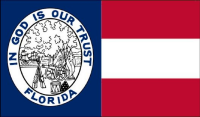
Early in 1861, the Florida legislature passed an act directing Governor Madison S. Perry to adopt “an appropriate device for a State flag which shall be distinctive in character.” On September 13, 1861, the governor reported that the new state flag had been deposited in his office, and the secretary of state recorded a description of Florida’s first official state flag. Whether the flag was ever raised over the capitol or on the battlefield is unknown. This illustration is based on the written description.
The flag featured above the crest to the left on the plate was a one-off kept in the governor’s office, not carried into battle by anyone nor flown in the state because they were too expensive.
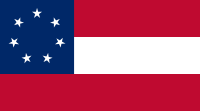
Thanks to the existence of photography an exhaustive search of archives revealed that this, the first version of the “stars and bars”, was the only Confederate flag flown in Florida. The Florida legislature was cheap, and they weren’t interested enough in the Confederacy to spend a lot of money on it buying new flags.
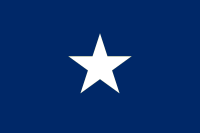
I have this flag in my sidebar as a joke. The “bonnie blue flag” belonged to the 90-day wonder of 1810, the Republic of West Florida. The joke is that the Republic didn’t include any part of the state of Florida. At one point under Spain, West Florida ran from the Apalachicola River to the Mississippi River, but after multiple wars and territorial swaps what became the Republic of West Florida ran from the Perdido River, the current western boundary between Florida and Alabama, to the Mississippi River.
One of the main reason James Madison of Virginia annexed the Republic of West Florida was the unease of the planters in what would become the states of Alabama, Mississippi, and Louisiana about the Republic controlling the ports into the northern Gulf of Mexico. Appropriating the flag of a country you destroyed is a bit mean-spirited.
The flag has nothing to do with the state of Florida, or the original US territory of Florida gained from Spain in 1821.
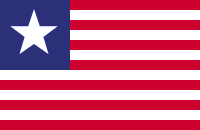
This is the flag that Colonel William H. Chase, the commander of Florida troops in Pensacola raised after capturing the Pensacola Naval Yard. He called it the flag of Florida Troops, but was told to take it down when it was recognized as the Republic of Texas Naval Ensign, probably taken from a flag locker at the Naval Yard. They then raised the first Confederate national flag with the circle of seven stars.
When Braxton Bragg took over military command in the area, he didn’t have a special flag, unlike several Confederate commanders, so units were free to create their own.
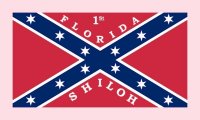
This flashy number was the regimental flag of the First Florida Infantry late in the war [Shiloh was April, 1862], which is similar to the Army of Tennessee battle flag splashed all over the plate, well, except for the pink border [silk dress fabric, and definitely pink] and the 12 six-pointed stars vice 13 five-pointed stars. If they had used this flag, I couldn’t complain because it would be historically accurate. In case you were wondering, yes, five-pointed stars are more expensive that six-pointed stars because they are more difficult to make.
If this plate was about Florida’s Civil War heritage as claimed, why not use symbols of Florida’s heritage? The cactus-eagle and Cherokee rose buttons are fine, but the flags are not historically accurate, and there are photographs that prove it.
While I’m on the subject, it specifically is not a St. Andrew’s cross on the flag. Most of the original candidates for a flag used a cross, but they went with the saltire, a form from heraldry, to avoid any religious significance after complaints from Jews who supported the Confederacy. The references to “St. Andrew’s cross” came long after the end of the war. Why would the South select the patron saint of Scotland for inclusion in their symbols?



































6 comments
You know, as soon as I saw this report on the news, this feature of yours was the first thing I thought of. I’ve been looking forward to reading this post for about a week. 🙂
Next year will be the 450th anniversary of the first settlement in Pensacola and Florida, which was short-lived because of a hurricane [who would have thought] but it is absurd that with 450 years worth of history, a group of whackos concentrates on a five-year period of madness to the exclusion of everything that happened before or after.
My Dutch ancestors ruled Delaware, New Jersey, New York, and Connecticut for 50 years and I don’t want a special license plate to commemorate the period, especially since they gave it away as essentially a “wedding present/bride price” to the then Duke of York who would become James II of Britain.
Two thoughts occur to me about this plate:
How soon will someone order it and try to get WHT PWR as the personalized plate?
And how long will a car with this plate last unmolested in certain neighborhoods in Miami, West Palm, Lake Worth, Tampa, or St. Pete?
Just sayin’…
The plate is an accident waiting to happen and no one is fooled by the rhetoric. I’m truly sick of this crap coming from a group of people who are likely if they can identify their father, much less their great-great grandfather.
While I was complaining about this, I was reminded that this is a free country. But I, personally, think this is equivalent to yelling “Fire” in a crowded theater. Maybe one day we will be the state (the country?) who thinks of others first. Obviously today is not that day.
And my grandmother is full blooded German. I don’t hand swastikas all over the place!
If they want to celebrate Florida’s heritage during that period, make it Florida’s, which was minimal. There’s no reason to import problems from other states.